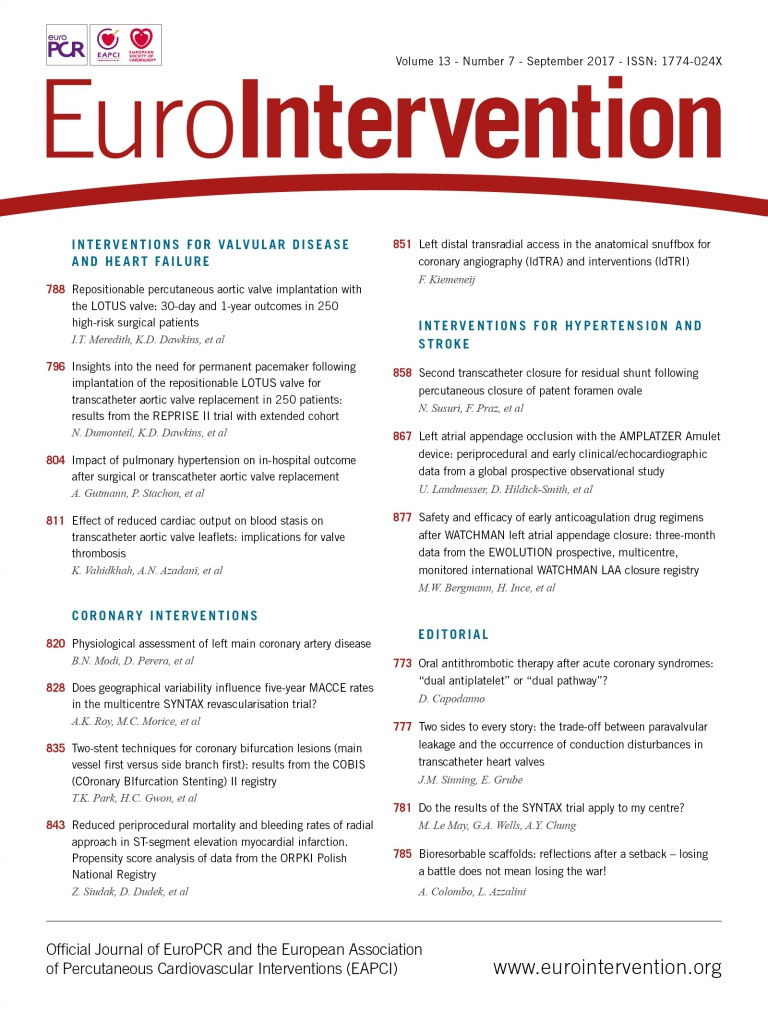
We read with interest the article by Ming Fam et al1 entitled “Everolimus-eluting bioresorbable vascular scaffolds for treatment of complex chronic total occlusions”, published recently in your journal. This study suggests the feasibility of bioresorbable vascular scaffold (BVS) implantation in complex coronary chronic total occlusion (CTO) with both good immediate angiographic results and six-month clinical outcome. We however have some comments to make.
It would have been interesting to have had a follow-up angiography in the patients. Indeed, angiographic in-stent restenosis, including total reocclusion, often remains clinically silent in patients after percutaneous coronary intervention (PCI) for CTO2-4. It is therefore difficult to infer angiographic outcomes only from clinical symptoms. The rate of angiographic restenosis at six months after successful PCI for CTOs has been reported to be around 20% with drug-eluting stents3,4. The study by Ming Fam et al1 does not allow an assessment of the actual rate of in-stent restenosis in CTOs treated with BVS or to make a comparison with the rates of restenosis reported with drug-eluting stents in this subset of lesions. In addition, the rate of stent thrombosis which may also remain clinically silent after CTO PCI3,4 is not known in the study by Ming Fam et al1. As this latter complication has already been reported to be more frequent with BVS than with DES for simple non-CTO lesions5, one may fear even higher rates of stent thrombosis in CTOs treated by BVS, especially when the lesions are complex as in the work by Ming Fam et al1. Indeed, in their study1, lesion bending was present in 50%, calcifications in 70%, the mean total scaffold length was 60 mm and optical coherence tomography was performed in only 18% to ensure an optimal post-scaffold deployment. In the light of all the above-mentioned factors, one might have expected some cases of stent thrombosis that were not actually observed by the authors. This may have been due both to the lack of routine follow-up angiography and to the short duration of clinical follow-up. Also, the authors should have provided detailed information on the duration of dual antiplatelet therapy which is an important factor for late BVS thrombosis6. Finally, cases of coronary artery aneurysm after BVS have been described very recently7,8. In their literature review, Chua et al8 found that four of the nine reported cases of coronary artery aneurysm occurred after BVS implantation for CTOs. Deeper artery wall injury, especially with dissection/re-entry techniques, may enable the development of coronary artery aneurysm in CTO after BVS implantation. Again, the lack of follow-up angiography does not allow detection of the occurrence of this type of complication in the study by Ming Fam et al1. To conclude, the study by Ming Fam et al1 has the great merit of being the first one to show the feasibility of BVS implantation in complex CTOs. However, we believe that a randomised trial including a control group treated by latest-generation drug-eluting stents with a routine angiographic follow-up in addition to a long-term clinical outcome evaluation is necessary before extending the indication of BVS in CTOs.
Conflict of interest statement
The authors have no conflicts of interest to declare.

